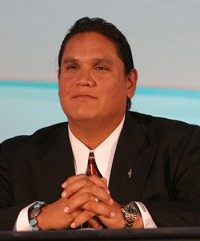
The U.S. Department of the Interior has been thrust into the spotlight of the gaming industry for the remainder of 2008 with its January denial of 22 total applications for off-reservation tribal casinos. The department’s process of communication, notification and application with the tribes during the past year has come under great scrutiny from the tribes themselves, and has touched off a cultural, legal and political battle sure to last throughout 2008.
“We always knew what (Secretary of the Interior) Dirk Kempthorpe’s philosophical differences were to gaming and off-reservation casinos, but this is to do with policy, not philosophy,” says Leslie Logan, spokeswoman of the St. Regis Mohawk Tribe in New York, whose application was denied. “To pull this out of thin air when we were at the finish line with our application has left us stunned.”
Eleven of the 22 letters to tribes informed them that their application for off-reservation gaming was incomplete, while the remaining half were notified that the Department of the Interior would not exercise its discretionary authority to take the respective properties into trust.
“I think he felt that if he would have granted one application, he would have had to grant them all,” says Logan.
Through 1934’s Indian Reorganization Act (IRA), the Secretary of the Interior has discretionary authority to take off-reservation Indian land into trust. The act was enacted to provide a tribal land base on which tribal communities can flourish.
Specifically, Part 151 of Section 151.11 details the factors the Department of the Interior is to consider when exercising its authority. Part 151 details two provisions relevant to applications that involve land that is a considerable distance from the reservation. As the distance increases between the tribe’s reservation and the land that is to be acquired increases, the secretary has to give greater scrutiny to the tribes’ justification of anticipated benefits from the acquisition and greater weight to the concerns raised by state and local governments as to the acquisition’s potential impacts on regulatory jurisdiction, real property taxes and special assessments. However Part 151 does not specifically elaborate further on how or why the department is to give greater scrutiny or greater weight to these factors as the distances increase.
“Our proposed project couldn’t get any more support than it has,” says Logan. “We have documented support from government representatives and agencies at the local, state and federal levels.”
Officials from the Department of the Interior declined interview requests from Tribal Government Gaming, and instead provided copies of the January letters sent to the 22 tribes along with the detailed Section 151 of the afore mentioned Indian Reorganization Act and the Indian Gaming Regulatory Act of 1988 (IGRA).
Along with the 22 tribes notified, the department also declined to comment on the eight off-reservation tribal casino applications that have been left untouched without ruling during the entire process.
A Question of commutability & Communication
According to the department’s documents, distance, or communicability had to do with the denial of the 11 applications in January. The proposed distances range from 70 miles away for the United Keetoowah tribe in Oklahoma to 1,500 miles away for the Seneca-Cayuga tribe in Oklahoma. However, many distances are in the middle, including the Choctaw’s application for an off-reservation site 175 miles away in Mississippi, Lac du Flambeau’s application 304 miles away in Wisconsin and the St. Regis Mohawk tribe’s application 350 miles away in New York.
“We knew all along that Kempthorpe was opposed to off-reservation gaming, but when he was sworn in he made statements as if he were going to uphold IRA,” says Logan.
In the guidance issued to tribes in the department’s January correspondence, it clarifies how to interpret and apply the Part 151 terms “greater scrutiny” and “greater weight” when considering the taking of off-reservation land into trust status for gaming purposes. The guidance asks that specific questions be reviewed for those applications with lands that exceed a “commutable distance” from the reservation because of the impact that a distant acquisition may or may not have on life on the reservation. The guidance also emphasizes that as distance from the reservation increases, greater weight should be given to state and local concerns, including jurisdictional problems and potential conflicts of land use and the removal of the land from the tax rolls.
“The St. Regis Mohawk Tribe out of any tribe can demonstrate that we are a commuting tribe,” says Logan. “We have been commuting more than 100 years and can show a foot trail of Mohawk iron workers to Washington, D.C., Montreal, Detroit and New Hampshire.”
Along with these cities, tribe members still also commute on a monthly basis to Philadelphia; Columbus, Ohio; Buffalo and a dozen other cities.
“For them to say commutability and distance is a factor without even consulting with tribes and without due process makes us feel like we have been screwed,” says Logan.
At hearings in Washington, D.C. in late February, St. Regis Mohawk Tribal Chief Lorraine M. White testified before the House Natural Resources Committee’s oversight hearings on the Department of the Interior’s recently released guidance. White’s testimony was based on a series of favorable determinations over nearly 12 years.
“It is wholly apparent that the Interior is not only a vortex of contradictions, but is intent on making up rules as they go along, as it suits them,” White wrote in an open editorial letter dated March 3.
According to White’s letter, Committee Chairman Nick Rahall (D-West Virginia) questioned Assistant Secretary of the Interior Carl Artman’s communication with the tribes, of which he was unsure. White’s letter states that Artman testified that the Interior believed in tribal consultation, but reserved it for “special occasions” and explained there was “some communication” with tribes but was unable to specify exact consultations.
“It is a federal obligation that they did not fulfill,” says Logan. “Commutability is not a policy and they are masquerading it as a management tool and guideline.”
White’s letter states that Congressman Dale Kildee (D-Michigan) stated to Artman that “Indian tribes are not social clubs but are sovereign entities requiring more than casual communication.”
Logan says the St. Regis Mohawk Tribe attempted to initiate communications and meetings with the Department of the Interior numerous times in the past year, but that the department has been resigned to a strategy of “delay, delay and deny.”
An Environment for Economic Efficiency?
Both sides argue that the economic benefits of the tribes is its top priority. In the Department of Interior’s letter of denial to the St. Regis Mohawk Tribe and others, the department clearly states that the remote location of the proposed gaming facility can have significant negative effects on reservation life. The letter states that since the proposed casinos are not within a communicable distance of the reservation, residential tribal members would not be able to take advantage of the job opportunities if they want to remain on the reservation, or would be forced to move away to take advantage of the job opportunities. Neither scenario does anything, the department states, to cure the problem of high unemployment rates that plague most of the tribes.
Employment of tribal members is an important benefit of tribal economic enterprises and the department is concerned that the departure of a significant number of reservation residents and their families could have serious and far-reaching implications for the remaining tribal community and its continuity as a community.
With the majority of tribes located in isolated rural areas, Logan and other tribal representatives worry that the “blanket guidelines” issued by the department will effect numerous smaller tribes who are attempting to place land into trust for residential use, not only for off-reservation gaming.
“There has to be a way for tribes to become more economically self-sufficient,” says Logan. “Forty percent of our tribe suffer from a lack of health services and we have a serious housing crunch, too. Every year the federal grants and contracts shrink, while costs and our population continues to increase.”
Moving Forward
In many ways the January issuance of letters of denials to the tribes opened more questions than it answered about the future of off-reservation gaming. Because of pending and possible litigation, many parties involved are reluctant to publicly speak about the issue, but all involved are unsure what the future holds.
Chairman Rahall may suggest legislation into law that ensures tribal consultation during the off-reservation gaming application process, or there may be a reversal from the courts or Congress that returns the applications back to the department for additional review. Another possibility is a grandfather clause, already suggested by several members of Congress that would reanalyze the 11 tribes denied.
“Since we were the closest, furthest along and most supported, if anyone deserves to be grandfathered in, it’s the St. Regis Mohawk Tribe,” Logan says.
Currently, the most likely scenario is held with the pending and anticipated legal action against the Department of the Interior. The St. Regis Mohawk Tribe has filed suite against the department for abuse of office and the failure to follow the letter of the law. Other tribes are anticipated to follow the St. Regis Mohawk Tribe’s lead.
“The department said they welcome any legal response and that is what we did,” says Logan. “If you put a nail in the coffin for off-reservation gaming without due process there are a lot of people who are going to be negatively affected, not just Indians.”










